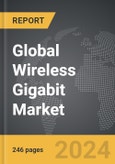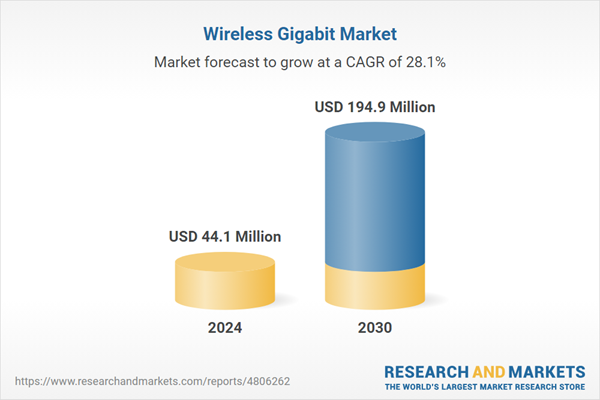The global market for Wireless Gigabit was valued at USD 44.1 Million in 2024 and is projected to reach USD 194.9 Million by 2030, growing at a CAGR of 28.1% from 2024 to 2030. This comprehensive report provides an in-depth analysis of market trends, drivers, and forecasts, helping you make informed business decisions.
Global Wireless Gigabit Market - Key Trends & Drivers Summarized
What Is Wireless Gigabit (WiGig) and Why Is It Transforming High-Speed Connectivity?
Wireless Gigabit (WiGig) is an emerging wireless communication technology that offers multi-gigabit per second data transfer rates over short distances using the 60 GHz frequency band. WiGig technology, based on the IEEE 802.11ad and 802.11ay standards, is designed to provide ultra-fast wireless connectivity for applications such as virtual reality (VR), augmented reality (AR), 4K video streaming, and high-speed data transfer. With its ability to deliver data rates up to 10 Gbps, WiGig is transforming high-speed connectivity in indoor environments, providing a seamless and wire-free experience for bandwidth-intensive applications. The growing adoption of WiGig in consumer electronics, enterprise networks, and industrial applications is driving demand for next-generation wireless solutions that can support ultra-high data rates and low latency.How Are Technological Advancements Enhancing Wireless Gigabit Solutions?
Technological advancements in millimeter-wave (mmWave) communication, beamforming, and phased array antennas are significantly enhancing the performance and capabilities of Wireless Gigabit solutions. The development of compact and low-power WiGig chipsets, which integrate advanced beamforming and MU-MIMO technology, is enabling more efficient and reliable data transmission, reducing signal degradation and interference in high-density environments. Innovations in antenna design, such as phased array antennas, are providing improved signal directionality and range, enhancing connectivity in challenging indoor settings. Additionally, the integration of WiGig with Wi-Fi 6 and 6E is enabling hybrid networks that combine the benefits of high-speed WiGig for short-range communication with the broader coverage of traditional Wi-Fi, offering a comprehensive wireless solution for homes, offices, and public spaces.What Are the Challenges and Opportunities in the Wireless Gigabit Market?
The Wireless Gigabit market faces several challenges, including limited range and penetration of the 60 GHz frequency band, potential interference issues, and high deployment costs for consumer and enterprise applications. Additionally, the need for specialized hardware and backward compatibility with existing Wi-Fi standards can impact the widespread adoption of WiGig technology. However, these challenges also present opportunities for growth and innovation. The increasing demand for high-speed and low-latency wireless connectivity in applications such as VR, AR, and 4K streaming is driving the need for advanced WiGig solutions that offer multi-gigabit data rates. The development of hybrid WiGig and Wi-Fi networks, which provide seamless connectivity across different frequency bands, is gaining traction among service providers and enterprises seeking to optimize network performance and user experience. Moreover, the expansion of smart cities, digital workplaces, and industrial automation is driving the need for ultra-fast wireless networks that can support real-time data transfer and low-latency communication.What Is Driving the Growth of the Wireless Gigabit Market?
The growth in the Wireless Gigabit market is driven by several factors, including the rising demand for ultra-fast and low-latency wireless connectivity, increasing adoption of VR, AR, and high-definition video streaming applications, and technological advancements in mmWave communication and beamforming technologies. The need for high-speed wireless solutions that can support bandwidth-intensive applications in consumer electronics, enterprise networks, and industrial automation is significantly boosting market demand for WiGig technology. Technological innovations in WiGig chipsets, phased array antennas, and hybrid network integration are enhancing the performance and scalability of WiGig solutions, making them more attractive to device manufacturers, service providers, and enterprises. The expansion of digital entertainment, remote working, and smart city initiatives, coupled with the growing focus on network optimization and user experience, is also driving market growth as stakeholders seek advanced wireless solutions that offer multi-gigabit data rates and low latency.Report Scope
The report analyzes the Wireless Gigabit market, presented in terms of market value (USD Thousand). The analysis covers the key segments and geographic regions outlined below.Segments
Product (Network Infrastructure Devices, Display Devices); Technology (System on Chip, Integrated Circuit Chip); Application (Consumer Electronics, Commercial, Networking).Geographic Regions/Countries
World; United States; Canada; Japan; China; Europe (France; Germany; Italy; United Kingdom; and Rest of Europe); Asia-Pacific; Rest of World.Key Insights:
- Market Growth: Understand the significant growth trajectory of the Network Infrastructure Devices segment, which is expected to reach $121 Million by 2030 with a CAGR of a 28.7%. The Display Devices segment is also set to grow at 27.2% CAGR over the analysis period.
- Regional Analysis: Gain insights into the U.S. market, valued at $12.5 Million in 2024, and China, forecasted to grow at an impressive 26.6% CAGR to reach $28.6 Million by 2030. Discover growth trends in other key regions, including Japan, Canada, Germany, and the Asia-Pacific.
Report Features:
- Comprehensive Market Data: Independent analysis of annual sales and market forecasts in USD from 2024 to 2030.
- In-Depth Regional Analysis: Detailed insights into key markets, including the U.S., China, Japan, Canada, Europe, Asia-Pacific, Latin America, Middle East, and Africa.
- Company Profiles: Coverage of major players such as BEC Technologies, Blu Wireless Technology, Ltd., Cisco Systems (India) Pvt., Ltd., Edgecore Networks Corporation, Harmonic, Inc. and more.
- Complimentary Updates: Receive free report updates for one year to keep you informed of the latest market developments.
Why You Should Buy This Report:
- Detailed Market Analysis: Access a thorough analysis of the Global Wireless Gigabit Market, covering all major geographic regions and market segments.
- Competitive Insights: Get an overview of the competitive landscape, including the market presence of major players across different geographies.
- Future Trends and Drivers: Understand the key trends and drivers shaping the future of the Global Wireless Gigabit Market.
- Actionable Insights: Benefit from actionable insights that can help you identify new revenue opportunities and make strategic business decisions.
Key Questions Answered:
- How is the Global Wireless Gigabit Market expected to evolve by 2030?
- What are the main drivers and restraints affecting the market?
- Which market segments will grow the most over the forecast period?
- How will market shares for different regions and segments change by 2030?
- Who are the leading players in the market, and what are their prospects?
Some of the 46 major companies featured in this Wireless Gigabit market report include:
- BEC Technologies
- Blu Wireless Technology, Ltd.
- Cisco Systems (India) Pvt., Ltd.
- Edgecore Networks Corporation
- Harmonic, Inc.
- Hitron Technologies Inc.
- Intel Corporation (UK)
- iWitness
- Mercusys Technologies Company Limited
- NET100, Ltd.
Table of Contents
I. METHODOLOGYII. EXECUTIVE SUMMARY2. FOCUS ON SELECT PLAYERSIII. MARKET ANALYSISIV. COMPETITION
1. MARKET OVERVIEW
3. MARKET TRENDS & DRIVERS
4. GLOBAL MARKET PERSPECTIVE
UNITED STATES
CANADA
JAPAN
CHINA
EUROPE
FRANCE
GERMANY
ITALY
UNITED KINGDOM
REST OF EUROPE
ASIA-PACIFIC
REST OF WORLD
Companies Mentioned (Partial List)
A selection of companies mentioned in this report includes, but is not limited to:
- BEC Technologies
- Blu Wireless Technology, Ltd.
- Cisco Systems (India) Pvt., Ltd.
- Edgecore Networks Corporation
- Harmonic, Inc.
- Hitron Technologies Inc.
- Intel Corporation (UK)
- iWitness
- Mercusys Technologies Company Limited
- NET100, Ltd.
Table Information
| Report Attribute | Details |
|---|---|
| No. of Pages | 246 |
| Published | April 2025 |
| Forecast Period | 2024 - 2030 |
| Estimated Market Value ( USD | $ 44.1 Million |
| Forecasted Market Value ( USD | $ 194.9 Million |
| Compound Annual Growth Rate | 28.1% |
| Regions Covered | Global |









